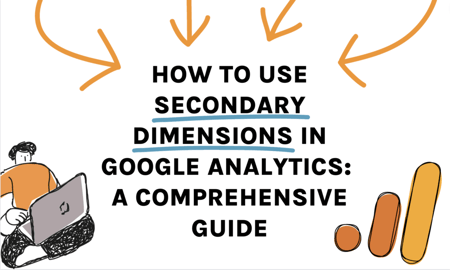From Information to Approach: Just How Secondary Dimensions Boost Your Search Engine Optimization Efforts
From Information to Approach: Just How Secondary Dimensions Boost Your Search Engine Optimization Efforts
Blog Article
Enhance Your Data Analysis Utilizing Second Measurements
The real deepness of understandings lies in the integration of second dimensions. The strategic use of second measurements boosts analysis beyond the surface degree, guaranteeing a wealth of untapped potential waiting to be found.
Comprehending Additional Dimensions
Secondary measurements in data evaluation refer to additional features or metrics that supply much deeper understandings when integrated with primary information dimensions, improving the overall understanding of the dataset. These added dimensions supply an even more detailed sight of the data, enabling experts to reveal hidden patterns, relationships, and trends that might not appear when just thinking about key measurements.
By integrating additional dimensions right into data evaluation, analysts can acquire an extra nuanced understanding of the elements influencing the main metrics. In advertising and marketing evaluation, primary measurements can consist of fundamental consumer demographics like age and sex, while second measurements can incorporate variables such as purchasing behavior, preferences, or geographic place. By incorporating these secondary and key dimensions, analysts can create much more comprehensive client accounts, allowing more targeted and effective advertising and marketing approaches.
Additionally, second measurements can aid in recognizing correlations between various variables, resulting in more exact anticipating modeling and decision-making. They allow experts to explore information from numerous point of views, enriching the understandings drawn from the dataset and ultimately boosting the quality of analysis and calculated recommendations.
Advantages of Secondary Dimensions
When considering data analysis, including additional dimensions offers a wide variety of advantages that considerably improve the depth and breadth of understandings originated from primary data dimensions. One of the crucial advantages of additional dimensions is the ability to give context to key data. By including additional measurements such as time, area, or demographic details to the evaluation, researchers can gain an extra extensive understanding of the key information points - secondary dimensions. This contextual info can help determine patterns, patterns, and relationships that may have or else gone undetected.
Moreover, second measurements can also assist in segmenting information, permitting a more in-depth analysis of certain subsets within the key information. This division can lead to even more targeted strategies and actions based upon the distinct features of each segment. Additionally, second measurements can aid in validating findings from main information dimensions, supplying a much more dependable and durable basis for decision-making.
Essentially, the advantages of incorporating secondary dimensions into data evaluation are vital, offering richer insights and making it possible for more enlightened decision-making procedures.
Executing Second Measurements Efficiently
Reliable execution of secondary dimensions in data analysis requires a strategic strategy that makes best use of the utility of extra contextual details. When integrating additional measurements, it is crucial to align them with the main dimensions to gain deeper insights right into the data. Begin by clearly specifying the goals of the evaluation to establish which secondary measurements will supply the most appropriate context. It is crucial to select additional measurements that complement the primary data without causing sound or confusion in the evaluation.
Furthermore, take into consideration the scalability of the additional dimensions throughout various datasets or evaluations. Guarantee that the picked second dimensions can be continually used and analyzed across various circumstances to maintain the stability and uniformity of the evaluation. Establish an organized process for incorporating secondary dimensions right into the analysis operations to simplify the interpretation of outcomes. By applying additional measurements efficiently, analysts can improve the depth and precision of read their information evaluation, causing more educated decision-making and workable insights.
Advanced Techniques With Second Measurements
For a much more sophisticated approach to data analysis, incorporating additional measurements can significantly raise the deepness of understandings acquired. Advanced methods with secondary dimensions entail more complex methods to draw out beneficial info from information collections.
An additional advanced method is regression analysis, which aids recognize connections in between variables and just how they affect each various other. By including secondary dimensions, such as market info or individual habits, to regression models, you can discover more nuanced insights and make even more precise forecasts.

Study: Second Dimensions at work

In another circumstance, a doctor leveraged second measurements to maximize resource allowance. By assessing person end results in connection with geographical place, the company determined locations with high readmission prices. This resulted in the application of targeted intervention programs in those areas, inevitably improving person care and minimizing health care expenses.
These study show the power of second dimensions in revealing useful insights that drive tactical useful site decision-making. By diving deeper into data analysis beyond main metrics, companies can obtain a much more thorough understanding of their operations and customers, resulting in more efficient and enlightened service strategies.
Final Thought
In conclusion, the incorporation of additional dimensions in data analysis is crucial for gaining a comprehensive understanding of underlying aspects and fads. By utilizing strategies such as associate analysis and regression analysis, organizations can discover hidden insights and make more informed decisions. Secondary measurements add depth and breadth to data analysis, permitting businesses to check out data from multiple perspectives and drive extra efficient results.
In marketing evaluation, primary dimensions might include basic customer demographics like age and sex, while secondary dimensions could incorporate variables such as purchasing behavior, choices, or geographic place.When considering data analysis, incorporating secondary dimensions supplies a wide range of benefits that substantially enhance the deepness and breadth of understandings obtained from key information measurements.In addition, secondary measurements can additionally assist in segmenting information, allowing for an extra detailed evaluation of certain parts within the main data. In addition, secondary dimensions can aid in verifying findings from primary data measurements, you could look here giving an extra durable and reliable basis for decision-making.
When integrating second dimensions, it is essential to align them with the primary dimensions to acquire much deeper understandings into the information.
Report this page